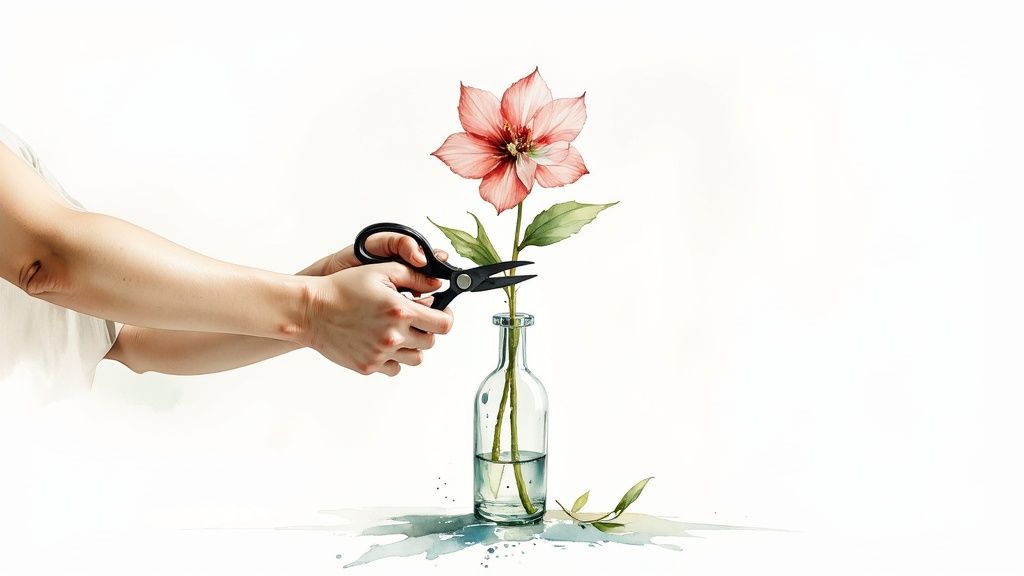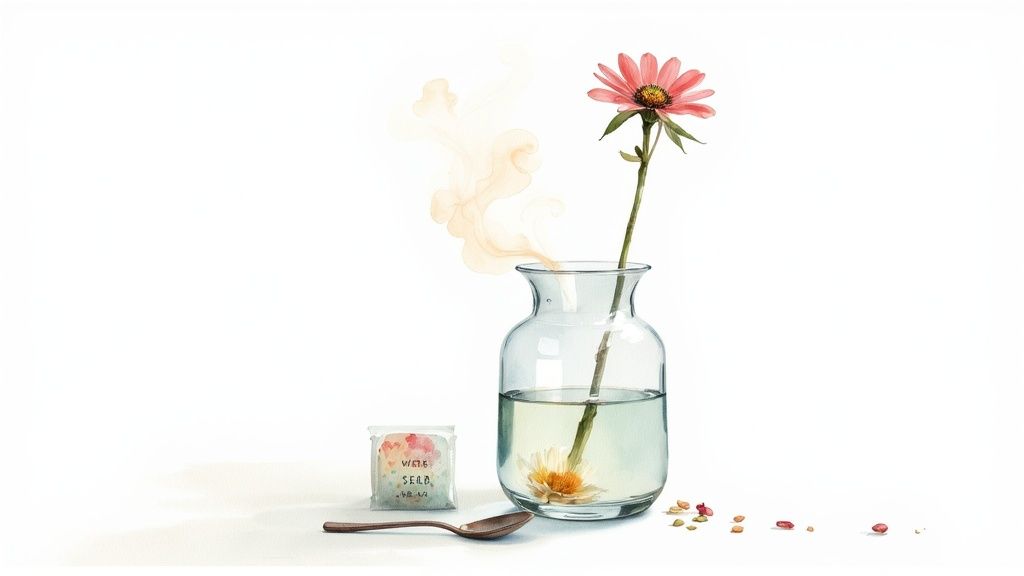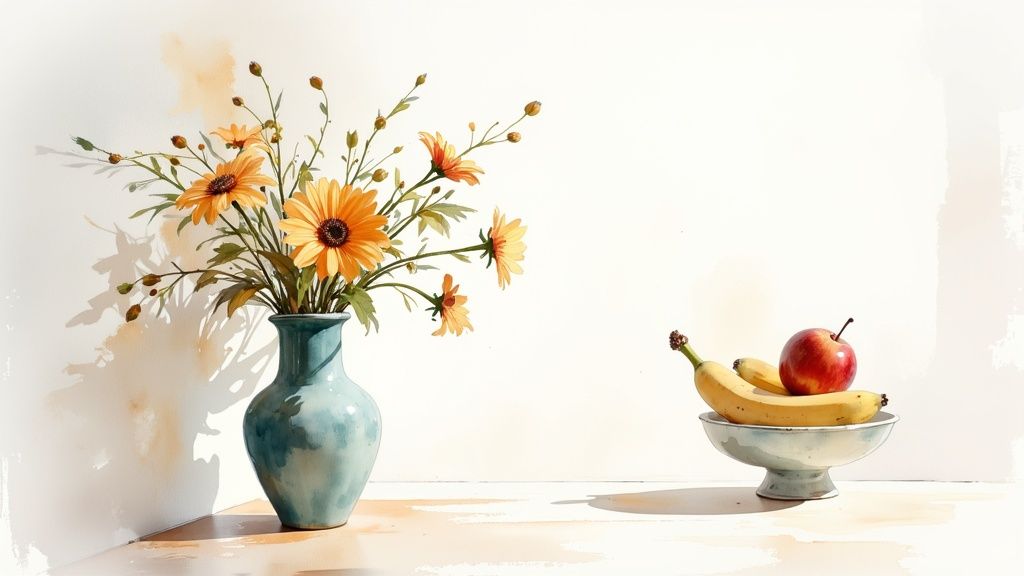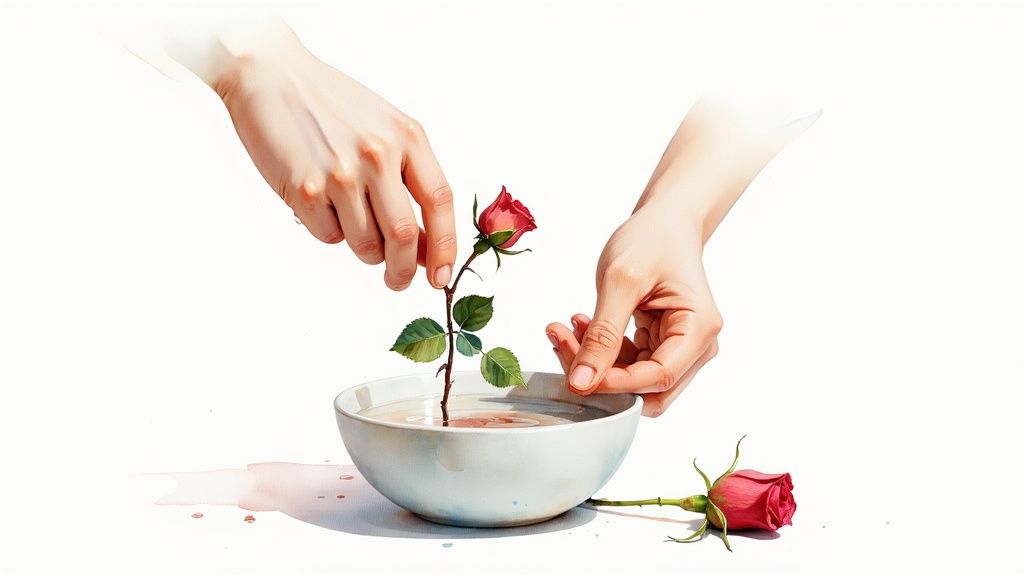The secret to making your fresh flowers last isn't some complicated trick—it's all about how you treat them in the first few minutes after bringing them home. Just a little prep work can make all the difference.
The Secrets to Prepping Your Flowers for a Longer Life

The journey to a vibrant, long-lasting bouquet begins the moment you walk through the door. Think of this initial prep as setting the stage for a great performance. If you skip these crucial first steps, your flowers simply won't have what they need to thrive.
Properly preparing your blooms isn't just a fussy floral tradition; it’s rooted in science. Once a stem is cut, it immediately tries to heal itself. This process can trap tiny air bubbles in its vascular system, which act like a roadblock, preventing water from getting where it needs to go. This is exactly why that first trim is so non-negotiable.
The Perfect Cut for Maximum Hydration
Your goal here is to create a wide-open channel for the stems to drink. A quick, straight snip with a pair of dull kitchen scissors will just crush the stem's delicate cells, making it nearly impossible for them to absorb water. It’s the fastest way to a sad, droopy bouquet.
Instead, grab a pair of sharp floral snips or even a clean knife. Trim about one inch off the bottom of every stem, but here’s the key: make the cut at a sharp 45-degree angle. This clever angle increases the surface area for water uptake and stops the stem from sitting flat against the bottom of the vase, which would block it off completely.
For bonus points, try making the cut under cool, running water. This simple move prevents air from getting sucked into the stem right after you've made the fresh cut.
Pro Tip: Don't let your freshly trimmed flowers sit out on the counter. Have your vase filled and ready to go so you can transfer them immediately. This minimizes their exposure to air and gives them the best possible chance at rehydrating right away.
Why You Must Remove Lower Leaves
This is probably the most common mistake I see, and it’s a bouquet-killer. Any leaves left below the waterline will start to rot almost immediately. This turns your vase water into a breeding ground for bacteria, which not only smells bad but also creates a toxic soup that will poison your flowers from the stems up.
Before a single stem goes into the water, carefully pluck off all the leaves that will be submerged. It takes a minute, but this one action is your best defense against premature wilting. It's an absolute must for anyone who wants to enjoy their blooms for more than a few days.
Once your stems are perfectly prepped, you can have fun arranging them. For some beautiful inspiration, check out these stunning fresh flower arrangement ideas to really showcase your work.
Mastering the Art of Water and Nutrients

Alright, you’ve made those perfect cuts. Now comes the part that makes or breaks your bouquet's lifespan: the water and nutrients you provide. Think of your flowers as being in recovery. They've just been separated from their root system and are stressed, thirsty, and desperately need energy. Getting them into the right water solution quickly is everything.
Fresh, clean water is the obvious starting point, but the details—like temperature and what you mix into it—are what will really make your blooms sing.
The Right Mix: Water Temperature and Flower Food
Here’s a little tip that feels backward but works wonders: start with lukewarm water. I know, it's tempting to use ice-cold water, thinking it's "fresher." But flowers can actually absorb slightly warm water much more easily, which helps them rehydrate faster after their journey to you.
And that little packet of flower food that comes with your bouquet? It’s not just for show. It's a precisely formulated cocktail designed to keep your flowers going. It’s got three key ingredients doing very different jobs:
- Sugar: Pure energy. This is the food your flowers need to keep their color and encourage tight buds to open up.
- Acidifier: This balances the water's pH, making it easier for the stems to drink up all that water and the nutrients you just added.
- Biocide: This is the unsung hero. It’s a disinfectant that stops bacteria and fungi from growing in the vase, which is the number one cause of clogged stems and premature wilting.
The single most important thing you can do for your fresh flowers is keep their water clean. Once bacteria takes over, it creates a sludge that blocks the stems, and it doesn't matter how beautiful the arrangement is—it won't be able to drink.
If you're really serious about water quality, looking into home water filtration solutions can give your flowers a huge head start with the purest hydration possible.
Creating Your Own Flower Food
Don't have that little packet? No problem. Plain water is better than nothing, but you can do so much better with a few things you probably already have in your kitchen. Whipping up a DIY flower food solution is simple and gives your flowers the same essential support as the commercial stuff.
You're just trying to replicate the three key components: food, an acid to help with water uptake, and something to kill the germs.
For those moments when you've run out of the store-bought packets, here’s a guide to making your own effective flower food.
DIY Flower Food Solutions
A simple mix of household staples can keep your blooms fed and their water clean. The goal is to provide a sugar source for energy, an acid to improve water absorption, and a biocide to prevent bacterial growth.
| Ingredient | Purpose in Solution | Recommended Amount (per quart/liter of water) |
|---|---|---|
| Sugar or Lemon-Lime Soda | Serves as the primary energy source (food) for the blooms, fueling their metabolic processes. | 1 teaspoon sugar or ¼ cup soda (avoid diet versions). |
| Lemon Juice or Vinegar | Acts as an acidifier, lowering the water's pH to help the stems drink more efficiently. | 1 teaspoon of lemon juice or apple cider vinegar. |
| Household Bleach | Functions as a biocide, killing harmful bacteria and keeping the water clean and the stems clear. | A few drops (no more than ¼ teaspoon) to prevent damage. |
This simple recipe provides everything your flowers need to stay vibrant when you don't have a commercial packet on hand.
Stay on Top of It: A Consistent Routine is Key
Even the perfect mix of flower food won't last forever. Bacteria will eventually start to grow, so you have to be disciplined. You need to completely change the water every two days. I don't mean just topping it off—I mean dumping the old water, giving the vase a quick rinse, and refilling it with a fresh batch of water and flower food.
This simple, consistent routine is absolutely non-negotiable if you want to get the most out of your flowers. It’s this dedication to longevity that has spurred innovation in the floral world, leading to the rise of preserved and dried flowers that last for months or even years. Consumers love the idea of low-maintenance, lasting beauty, a trend that continues to shape the market.
Where You Put Your Flowers Matters More Than You Think

After all the careful prep work—snipping stems, mixing flower food, and choosing the perfect vase—it’s easy to think the job is done. But where you place that vase can either honor all your effort or undo it in a matter of hours.
The environment around your blooms plays a huge role in how long they'll stick around. Think of fresh-cut flowers as incredibly sensitive guests in your home; they react to everything. Temperature shifts, bright light, and even the air quality can turn a vibrant bouquet into a sad, droopy mess.
Heat and Sunlight: A Bouquet's Worst Enemies
That sunny spot on the windowsill? It might seem like the perfect stage for your beautiful flowers, but it's probably the worst place in the house for them. Direct sunlight and heat are a fast track to wilted petals.
Here's why: flowers are constantly losing moisture through their leaves and petals in a process called transpiration. When they're in a warm, sun-drenched spot, that process kicks into overdrive. They're essentially "sweating" out water far faster than their stems can drink it up, leading to dehydration, drooping, and faded colors.
To keep your blooms happy, find a spot for your vase that is:
- Out of the direct path of sunlight streaming through a window.
- Far from heat sources like radiators, heating vents, or even electronics that run hot, like a TV.
- Never on top of appliances that generate warmth, such as a microwave or the top of the fridge.
Commercial florists live by this rule. They keep their coolers between 1 to 5 degrees Celsius for a reason—it slows down the flowers' metabolism, essentially pausing the aging process. While you can't create a commercial cold chain at home, the takeaway is simple: a cool environment is absolutely essential for a long-lasting bouquet.
The Invisible Threat: Ethylene Gas
One of the sneakiest culprits behind premature wilting is something you can't even see or smell: ethylene gas. This is a natural plant hormone that basically tells flowers it's time to age, drop their petals, and call it a day.
And the biggest source in your home? That beautiful bowl of ripening fruit on your counter. Apples, bananas, and avocados are notorious for releasing ethylene as they ripen. Placing your flowers nearby is like putting them in a hyper-aging chamber. The gas signals the blooms to mature and fade, dramatically cutting their vase life short.
It’s not just about the obvious things, either. Other factors, like maintaining optimal indoor humidity levels, also play a subtle but important part in keeping your flowers fresh and hydrated.
So, Where's the Sweet Spot?
The best place for your arrangement is usually a spot that doesn't get a lot of action. Think about a cool corner in the living room, the center of a dining table that's far from a window, or even a guest room that stays consistently cool.
By being mindful of heat, direct light, and that sneaky ethylene gas, you're giving your flowers a stable, supportive home where they can thrive. It’s a tiny adjustment that can easily add days of beauty and enjoyment to your arrangement.
Ongoing Care That Makes a Real Difference
Getting your beautiful new bouquet into a vase is a fantastic start, but the real secret to making those blooms last lies in the day-to-day care. The initial prep gets your flowers in the race; this ongoing maintenance is what helps them finish strong.
It doesn’t have to be a chore. Just a few minutes every day or two will dramatically extend the vibrancy of your arrangement, letting you enjoy every last drop of its beauty. Think of it as a simple daily check-in that makes a world of difference.
The Power of a Fresh Cut
After a couple of days, the ends of the flower stems will naturally start to seal up, even in clean water. This creates a bottleneck that slows down hydration—it's often the first step toward a wilting bouquet. Giving your stems a fresh trim is like clearing a blocked straw.
Every two days, when you change the water, take the flowers out and give them a quick snip.
- Take off about a half-inch from the bottom of each stem.
- Always cut at that same 45-degree angle to create more surface area for drinking.
- Use sharp floral snips or a clean knife. A dull blade will crush the stem's delicate water-uptake channels.
This simple act reopens those pathways, allowing the stems to drink freely again. It’s one of the most effective tricks in the book for combating droopiness and keeping your flowers looking perky.
Daily Inspection and Culling
Not all flowers in an arrangement fade at the same pace. A quick daily look-over lets you spot trouble before it spreads. This is your chance to play detective and remove anything that’s past its prime.
Scan the bouquet for any blooms that are starting to wilt, turn brown, or drop petals. It’s absolutely crucial to pull these spent flowers out right away.
Why This Matters: Dying flowers release ethylene gas—the same hormone that ripens fruit. This gas sends a signal to the healthy flowers nearby, telling them to speed up their own aging process. Removing just one fading bloom can protect the entire bouquet.
This daily habit not only keeps your arrangement looking tidy but also actively prevents a chain reaction of decay. Plus, there’s nothing better than waking up to a fresh-looking bouquet every morning. For those who love having that continuous beauty in their home, a weekly flower delivery subscription can simplify everything, ensuring you always have new blooms to care for. By making these small steps part of your routine, you give your flowers the best possible chance to thrive.
Troubleshooting Common Flower Problems

Even when you do everything right, some flowers just seem to have a mind of their own. It can be frustrating to follow all the rules, only to find a sad, droopy rose or a stubbornly closed lily bud staring back at you. Don't worry—think of this as your flower emergency room, stocked with practical fixes for the most common floral issues.
Sometimes, a bloom isn't at the end of its life; it just needs a specific intervention to get back on track. Knowing these simple troubleshooting techniques can easily squeeze a few extra days of beauty from an arrangement that seems to be on its last legs.
Reviving Droopy Blooms
Ah, the dreaded "bent neck." It’s especially common in top-heavy flowers like roses and hydrangeas. This usually happens because a tiny air bubble gets trapped in the stem, creating a blockage that stops water from reaching the head. The result is a perfectly healthy-looking stem with a wilting, dehydrated bloom.
Thankfully, there’s a surprisingly effective fix. It involves a bit of shock therapy to force that air bubble out and get the water flowing again.
- First, grab a mug or small, heat-proof container and fill it with about an inch of very warm (not boiling) water.
- Next, re-cut the stem of the droopy flower at a sharp angle.
- Immediately place the freshly cut stem into the warm water for about 60 seconds. You might even see tiny bubbles escaping from the stem—that's the blockage clearing out!
- Finally, transfer the flower back into your main vase with cool, fresh water.
Within a few hours, you should see the bloom perk right back up as it starts to properly hydrate again. It’s a simple trick that has saved countless bouquets from the compost bin.
Don't give up on a wilting flower too quickly. Most of the time, drooping is a sign of a hydration issue, not the end of its life. A quick intervention can often bring it right back to its former glory.
Encouraging Stubborn Buds to Open
What about those beautiful lily or iris buds that just refuse to open? This is a common frustration, especially if the other flowers in your arrangement are already in full bloom. These shy flowers sometimes just need a little gentle encouragement.
A simple method is to re-trim their stems and place them in a separate vase filled with lukewarm water and a bit of flower food. The warmer temperature, combined with direct access to nutrients, often stimulates the buds to open. You can also try gently misting the buds with water, which helps soften their outer petals and makes it easier for them to unfurl.
By learning these quick fixes, you can tackle problems as they pop up and keep your arrangement looking beautiful. And for those truly special bouquets you want to enjoy forever, you might be interested in learning how to preserve a wedding bouquet, turning fleeting beauty into a lasting keepsake.
Answering Your Top Flower Care Questions
Even the most seasoned flower lover runs into questions. Flower care, after all, is surrounded by a lot of old wives' tales and "tricks" that have been passed down for generations. It’s time to cut through the noise.
Let's clear up some of the most common myths and tackle the tricky situations you're likely to face. Getting straight, science-backed answers is the real secret to keeping your blooms looking gorgeous for longer.
Do Home Remedies Like Pennies or Aspirin Actually Work?
This is probably the number one question we get, and the short answer is… not really. These popular hacks just don't hold up against a properly formulated flower food.
The theory with the penny is that copper acts as a fungicide, killing off nasty bacteria in the water. The problem? A modern penny contains so little copper that it has virtually zero effect. As for aspirin, it contains salicylic acid, which can help with water uptake in some living plants, but it's not formulated for cut flowers and completely lacks the essential sugars they need for energy.
The best thing you can possibly do is use the commercial flower food packet that came with your bouquet. If you've run out, a simple DIY recipe is far more effective than any of these myths. Just mix a little sugar (for food), a splash of lemon juice (an acidifier), and a few drops of bleach (to kill germs) into your water.
Why Are My Hydrangeas Wilting So Fast?
Ah, the famously dramatic hydrangea. It can be so frustrating to see them drooping just hours after you put them in a full vase of water. Don't worry, it's not you—it's them.
Hydrangeas produce a sticky sap, called mucilage, that can clog their own stems right after being cut. This creates a blockage that literally stops them from drinking, no matter how much water is available.
To bring a sad-looking hydrangea back to life, you need to clear that blockage. Here’s how we do it in the shop:
- Re-cut the stem at a sharp angle to create a fresh, clean surface.
- Dip the cut end into very hot (but not boiling) water for about 30 seconds. The heat helps dissolve that sticky sap.
- Immediately plunge the stem back into a vase filled with cool, fresh water.
If a bloom is severely wilted, you can even submerge the entire flower head in a sink or basin of cool water for 30-45 minutes to help the petals rehydrate directly.
Is Filtered or Distilled Water Better Than Tap Water?
For most bouquets, clean tap water is perfectly fine. This is especially true when you use the flower food packet, as it’s designed to balance the water’s pH and counteract some of the impurities you might find in tap water.
That said, there are a couple of exceptions. If your home has very hard water (high in minerals) or uses a water softener (which adds sodium), it can sometimes interfere with hydration for extra-sensitive flowers like gerbera daisies or certain rose varieties. In those specific cases, making the switch to filtered or distilled water can definitely give your arrangement a better shot by providing a cleaner, more neutral base.
Ready to bring lasting beauty into your home without the guesswork? The expert floral artists at Fiore create stunning, fresh arrangements designed for longevity. Explore our beautiful, hand-designed bouquets and enjoy same-day flower delivery across Los Angeles. Visit https://fioredesigns.com to find your perfect arrangement today.



